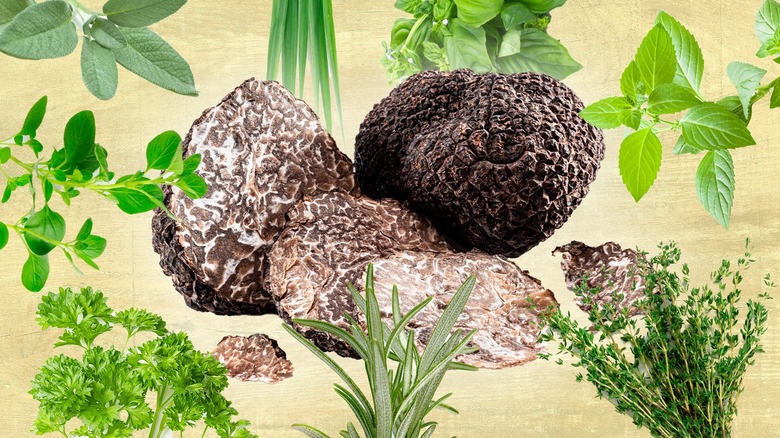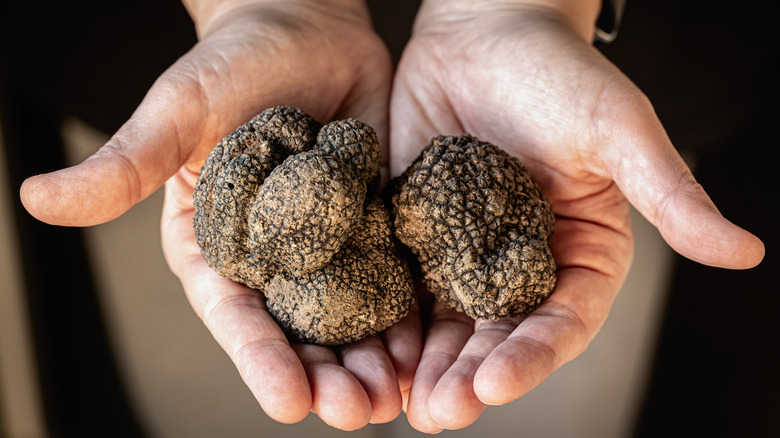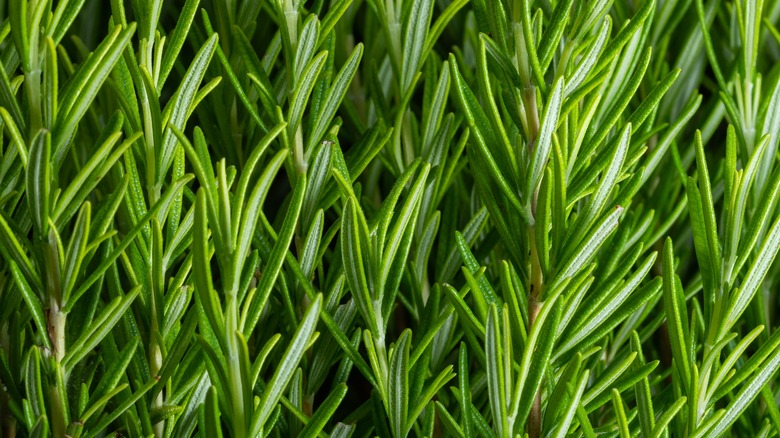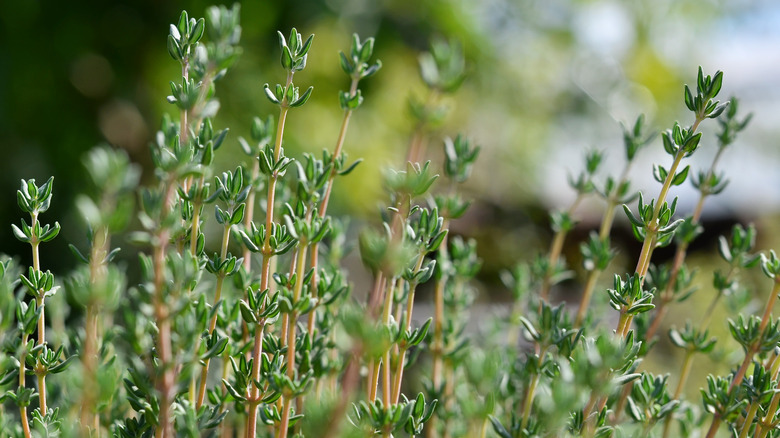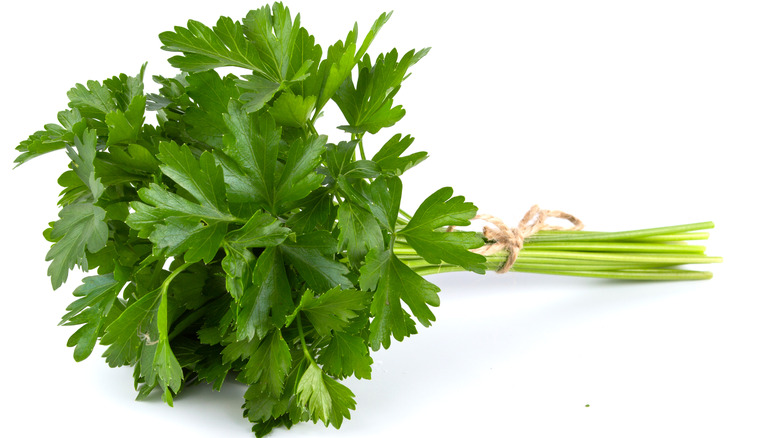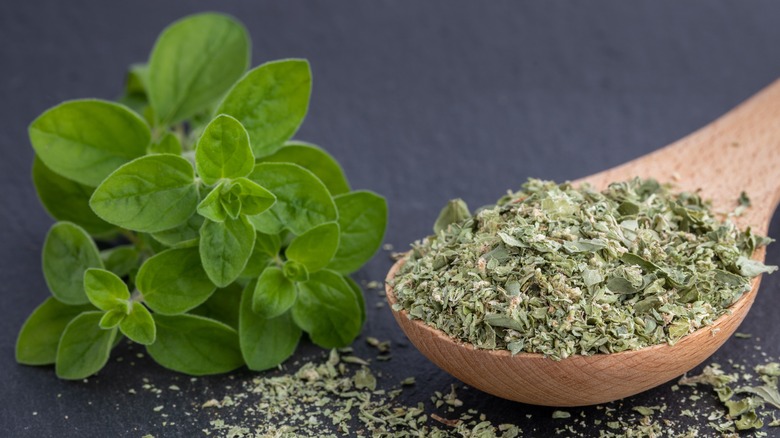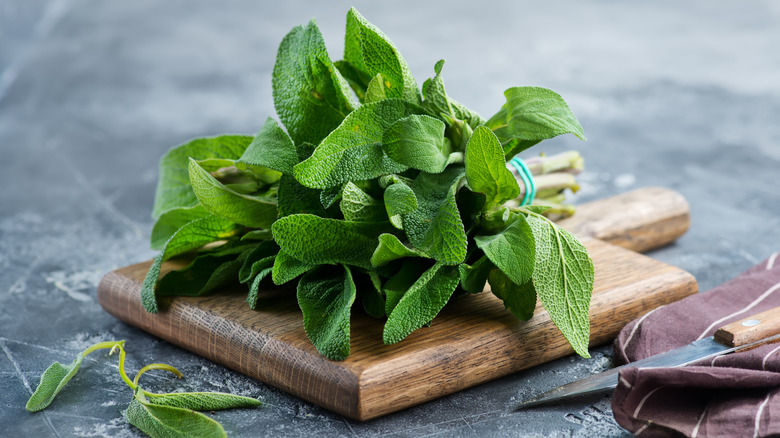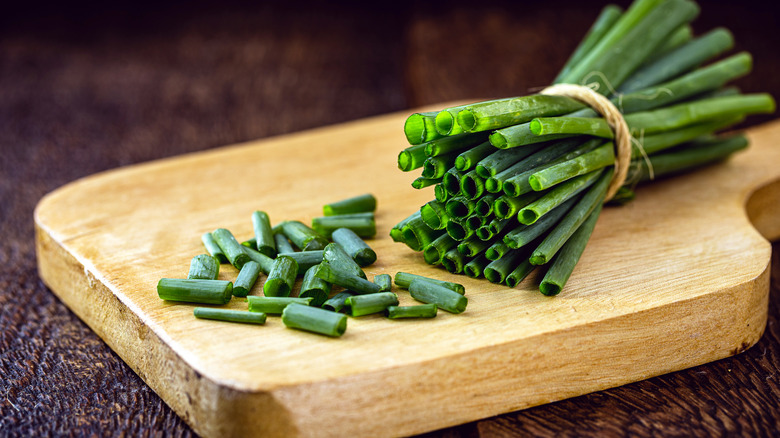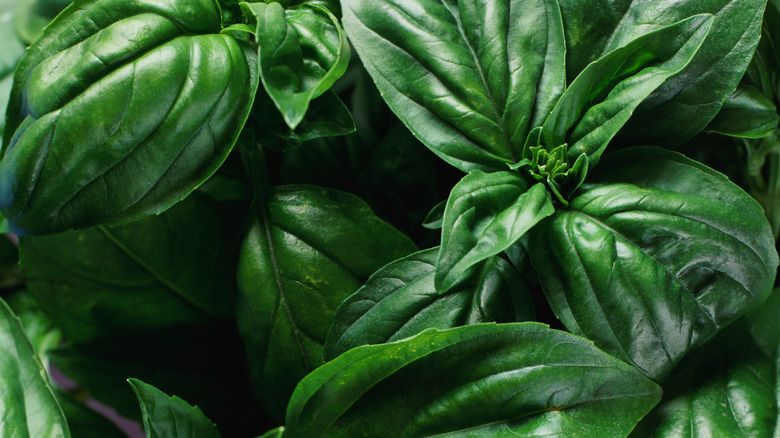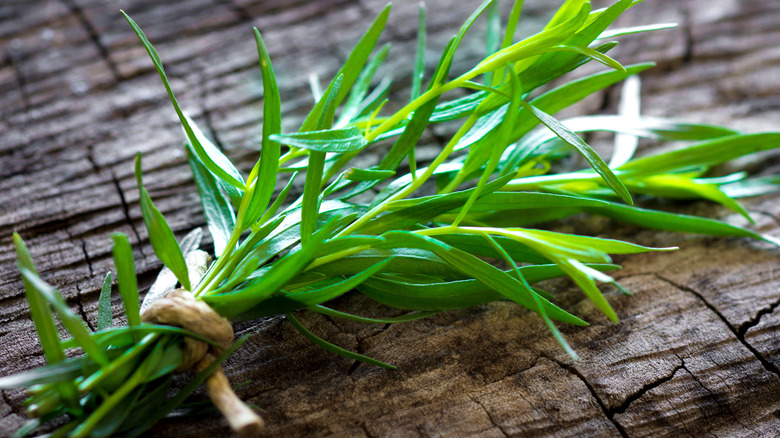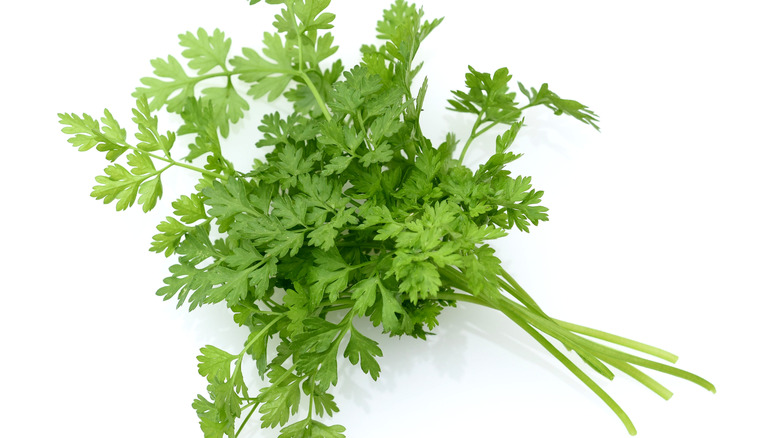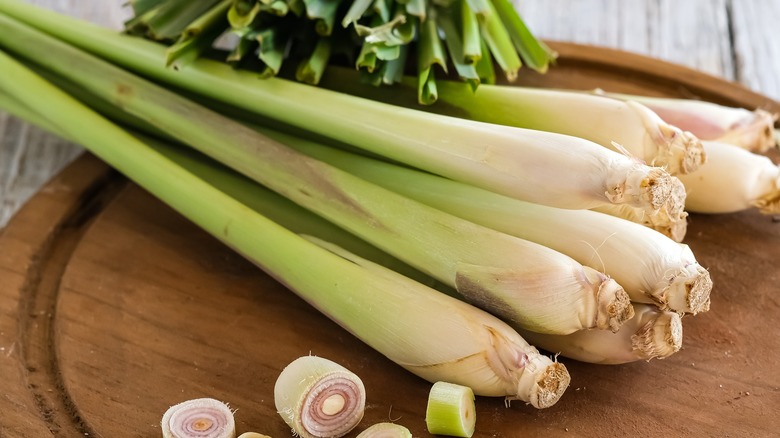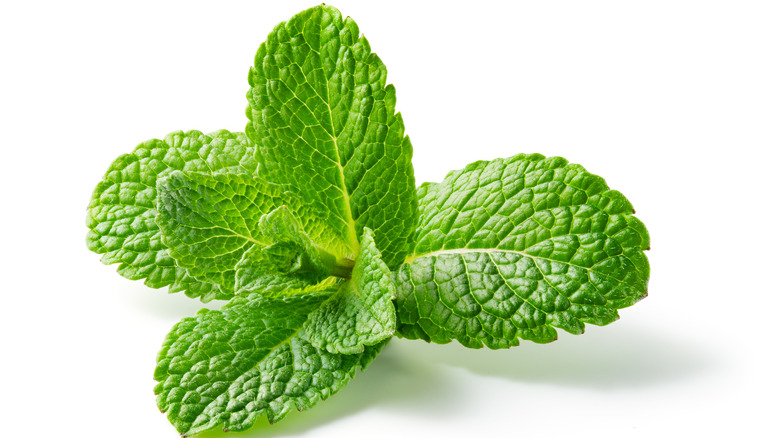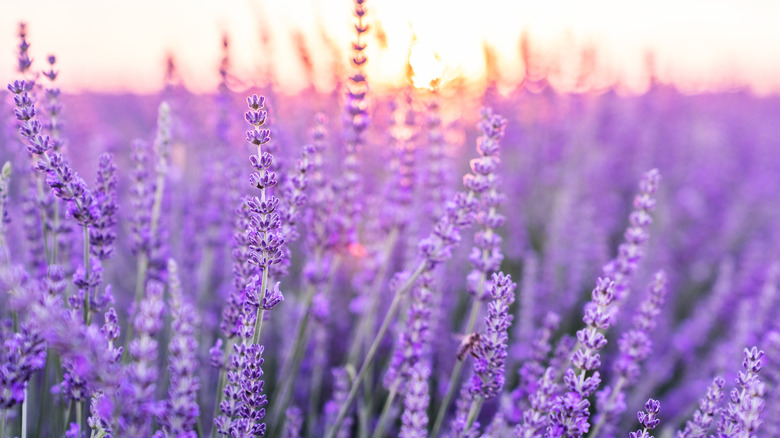Your Guide To Pairing Herbs And Truffles
Truffles are perplexing. Based on their description, they shouldn't be good — with aromas related in wide-ranging terms like cheesy, woodsy, leathery, gasoline-like, and vanilla-y. For every attractive descriptor, like "garlicky," there's a detractor, such as "rotten food." Yet, they've borne gastronomic reverence for centuries as a pinnacle of luxury.
To understand the attraction, let's start with what a truffle is. They're classified as a tuber, and while there are close to 100 different varieties of truffles, only a handful are edible or not repelling to the nose. Of that small selection of culinarily useful truffles, there are multiple differentiations based on their location, exterior color, skin texture, stage of development, and flesh color. For purposes here, we'll separate them into black (Perigord, Burgundy, Summer, and Winter are the most common varieties) and white (Alba, Bianchetto, Oregon) truffles. Black varieties carry fruitier, woodier notes, and white types are more subdued, with a garlicky aroma. While none are considered inexpensive, the white family carries a higher price tag.
As they represent an investment in your meal, it's understandable to have some hesitancy about using them and what to pair with them. Luckily, we're here to help with that.
The smell is your best guide
According to an article in Molecules, each truffle variety has a subtly-varying set of aromas and flavors created by volatile organic compounds (VOCs) made up of alcohols, aldehydes, sulfur compounds, and other contributors. Story short, there's a lot of fragrance going on with black and white truffles, and a significant portion of the flavor of anything comes from its smell.
Herbs carry their unique aromatic and flavor properties. Terpenes and other VOCs in herbs will either complement or clash with those of the truffle. Considering those elements, a good place to start with pairing truffles and herbs is letting scent be your first indicator; if they smell good together, chances are they taste good together. With rules, there are exceptions. Two elements to avoid are spice (heat) and acid, which will overwhelm the flavor of the truffle.
When pairing flavors and scents this way, it's best to list each ingredient's properties. For example, on one side, truffles are earthy, woodsy, and sometimes piney or garlicky. On another, thyme has woodsy, earthy, spicy, and floral notes. Draw lines between woodsy and earthy, leaving spicy and floral as outliers on the thyme side. Do those elements accentuate those already paired as well as those unpaired?
Rosemary
Let's take a closer look at terpenes. Although they're far more complex than this, the simplest explanation we can provide is they make plants smell the way they do. The most commonly-encountered example of terpenes in action is in essential oils. If you can identify the terpene in a plant, you'll get a clearer picture of how its scent will fare when facing truffles.
Rosemary is heavy in the terpenes camphene (woodsy, minty, herbaceous smelling), pinene (piney), limonene (citrusy), and myrcene (woodsy, spicy, earthy). Truffles, foraged in the woods, have the pungent earthy aromas of where they grow. Additionally, white truffles have a distinct garlicky aroma. Playing the scents of the truffles off the dominant terpenes of the rosemary, you'll find why each does well on french fries and why pairing the two on your fries should be a given, especially considering the number of snacks and salts on the market that already pair the two. Given the intense flavors of the truffle and the herb, it's best to exercise restraint with the rosemary to not battle with the expensive truffles.
Thyme
Thyme is the general name for a collection of about a dozen varieties of earthy herbs. Each variety has subtle or not-so-subtle hints that belie their name, like "lemon thyme." Without deep-diving into how each would interact with a truffle, we'll focus on common thyme or Thymus vulgaris. Although thyme possesses a slew of terpenes, the one most familiar to people is linalool, despite its lower percentage than others in the plant.
Linalool has a spicy, floral profile and is the primary aromatic component of oranges, bay leaves, grapes, and coriander. It's familiar, mainly due to its use in 60-80% of scented hygiene and grooming products. You might not know it by name, but you've encountered the scent many times. More on that later.
The lightness of linalool combined with the other earthy components of thyme accentuates and brightens the woodsy notes of truffles. This makes the truffle's flavor "pop" more predominantly by complimenting them. The pairing creates slightly more complexity by providing contrasting notes against the truffle's earthy or garlicky flavors and scents.
Parsley
Parsley, especially the curly variety, has gotten short-shrift since its relegation to garnish status some years ago. The flat-leaf, or Italian, type is considerably more delicate in flavor and scent than its curly relative and carries a distinct grassy, fresh, and sometimes peppery flavor. To avoid confusion from the previous assertion to not pair truffles with spicy foods, the peppery-ness of parsley lies more in the taste of peppercorns rather than in their heat components.
On top of these flavor qualities, parsley's dominant terpene is pinene. Pinene is a familiar scent, given its namesake, pine. You can also encounter it in herbs like rosemary, citrus, and brewing hops. When one considers the complex, earthy, woodsy tones of both black and white truffles, pinene is a natural flavor bridge to them, considering all the forest descriptors. After that, the backing notes of fresh grass and pepper from the parsley come into play, contrasting and amplifying them all.
Oregano
We won't lie; oregano was a bit of an outlier when creating this list, given its intense, pungent flavors and close association with pizza. The spice brand McCormick describes it as having an almost minty aroma that offsets its peppery, earthy bite. Looking at oregano's components, it's heavy in pinene, linalool, and limonene, which lend complexity to McCormick's brief description with notes of citrus and pine. It also contains the compounds thymol and rosmarinic acid. If those names sound like herbs already mentioned, you're correct. Although oregano is technically in the mint family, it shares similar chemical makeup with thyme and rosemary.
Looking at the common threads of shared terpenes and VOCs already mentioned, you can start drawing lines from oregano to truffle quite quickly. Like sage, oregano has a strong, distinctive flavor, and is easy to overuse. With that in mind, while the truffle-oregano pairing is quite effective, a judicious hand with the herb can save your truffle investment in your dish.
Sage
Sage is a powerful herb many in the U.S. are familiar with because of its use in country sausage, boxed stuffing, and as a staple for seasoning turkey and other poultry. It was and still does figure prominently in Indigenous American cultures for food, medicinal, and ceremonial purposes. Sage is also a staple of Mediterranean cooking, regularly appearing in Greek regional cuisines and, to a lesser extent, French cooking. In Italy, it's a staple, considered a natural pairing with gnocchi, gnudi, or malfatti, using just a few leaves to flavor an entire batch of dumplings because of its intensity.
Despite that assertiveness, a small amount can be subtle when paired with truffles, especially white ones, where the piney, citrusy qualities can shine against the subtle garlic notes. Because of the fuzzy texture of its leaves, we can't recommend you use raw sage with something as subtle as truffles. Fried and crumbled leaves or an infusion in a good, fruity olive oil would best convey the flavor without the odd texture. You can also flavor roasted meats or vegetables with sage or use it in pasta or risotto before finishing them with truffle.
Chives
With all the descriptors surrounding truffles, like earthy, cheesy, or garlicky, one could assume that they're an aggressive or dominant flavor. They are, to a degree, but it's easy to overpower them, too. However, they contain a sulfur-based VOC that carries barely-there oniony scents in addition to the garlicky aroma of white varieties. If you're seeking to pair with that, chives are a safe bet, as they lack the assertiveness of shallot or red or white onion. Chives are delicate members of the allium family that bring a subtle onion flavor to the table.
Chives constitute 25% of the herb blend known as fines herbes, along with parsley and two other herbs we'll soon discuss. A French staple, fines herbes is a non-negotiable component of a classic French herb omelet, often garnished in truffle season with a shower of the black or white varieties. After firmly suggesting the need for restraint with more aggressive herbs like sage or oregano, you can freely shower your truffles with chives with little adverse flavor effect. However, you can reach a point where their raw, vegetal crunchy texture may distract from that of the truffles.
Basil
Basil can run a gamut of flavors that pair well with black and white truffles. Although it's difficult to pin down, the number of cultivars, hybrids, and adjacent species number close to (or potentially more than) 100. Sweet and Genovese basils, familiar components of pesto, have lighter, citrusy, licorice aromas and flavors. Thai basil runs more clove-like, with more robust anise notes than the previous types. Lemon basil melds the flavors of sweet basil with more pronounced citrus notes. Story short, there are a lot of options when it comes to basil and truffle pairing.
The flavors of Thai basil are sharp but mellow with cooking, so keep that in mind when considering a pairing, especially with the more subtle white truffles. Linalool and limonene feature prominently in most types of basil, so knowing what we do now about these, they're a natural pairing with black and white varieties. Consider the flavor variations amongst varieties a bonus and play with them to fit your tastes.
Tarragon
Truffles are an essential flavoring garnish to New Orleans restaurant Antoine's classic dish, Eggs Sardou, in which poached eggs are paired with ham, anchovy, and asparagus, sauced with black truffle hollandaise. Why are we even talking about that? Well, it's a bit like doing a geometry class exercise where you must prove the degree of an angle. Classic hollandaise contains tarragon. So, working backward, tarragon is good in hollandaise, and hollandaise is good with truffles. Therefore, tarragon pairs with truffles. Whew.
There's always the chemical composition if you want a more direct route to effective pairing. Tarragon is a bright, earthy herb with a strong note of anise. Limonene and pinene give a bright-forward pop, while the anise flavors round out the overall taste. Using that same mathematical proof analogy, we've seen that limonene and pinene make good playmates for truffles in other herbs, so we can logically follow that it will work here, too. But to avoid the licorice flavors from overwhelming the truffle, we advise a light hand with the tarragon.
Chervil
Chervil is a restrained, delicate member of the parsley family. It has grassy, spicy notes like parsley but also brings licorice notes similar to tarragon, basil, or fennel. Chervil has its roots in eastern Europe, and conquering Romans grew fond of the herb in cooking, taking it for their own, believing in its medicinal properties in addition to its taste. Because of their attachment to it, Romans planted the herb in their colonized territories across Europe, which remains a staple today in France.
As it relates to pairing with truffles, chervil is a heretofore unnamed member of the fines herbs collection, along with tarragon, chives, and parsley. Operating on the assumption that if that combination of herbs plays well as a group with truffles, and each herb thus far shows well in individual pairing, chervil would follow suit by default. If more proof is needed, chervil has a myrcene content that can attribute to as much as almost half of its aroma and flavoring profile, which we've previously mapped to make a good pairing.
Lemongrass
Although lemongrass's origins are in India and Southeast Asia, and truffles are mostly of European origin, there's no reason they can't be global friends. Because of their earthy, sometimes garlicky aroma, truffles almost beg for a citrusy accompaniment. Still, they would suffer greatly in the presence of the acidic properties that lemon or even orange would bring. Enter lemongrass.
Lemongrass is a close relative of citronella, which many know as a natural insect repellent. They share a natural citrus scent and are highly representative of the terpene limonene. Lemongrass has an aroma and flavor reminiscent of a cross between lemon and mint. As flavor and aromas are subjective, some people pick up on ginger-like flavors in the herb in it as well. Given those ginger flavors, let's take this opportunity to suggest that ginger, in limited quantities, might make a good pairing as well — but it's a spice, and outside the theme of this article.
Even when chopping it finely or mashing in a mortar and pestle, the fibrousness of lemongrass can detract from the overall truffle experience. Because of that, consider introducing lemongrass as a cream, an infused oil, infused salt, or aioli to avoid the textural clash.
Mint
Mint is one of the world's most widely used herbs. With about 25 species comprising the mint family, it finds its way into sweet and savory dishes across the globe in numerous iterations. Although there's variation across species, the dominant terpenes that help define mint's flavors are caryophyllene, linalool, and limonene. At this point, we don't need to rehash these terpenes as excellent contributors to truffle pairing.
Because of the multiple varieties of mint, you can play with the background flavor profiles they bring to craft your end game. As their names suggest, peppermint and spearmint are more sharply flavored and aggressive. Going further down the path, you'll find varieties more commonly used in tea-making, like Moroccan or mojito mints. Then, we get into niche-flavor mints like lemon, pineapple, or chocolate varieties.
You can cook mint into the main item you're pairing your truffles with, like meats, vegetables, or pasta, or it can be a finisher for the dish. Infused creams, aiolis, oils, or finely chopped leaves are also good vehicles for conveying the flavor.
Lavender
Lavender is rich in linalool, and the overall calming effect of that terpene and other VOCs in lavender is why you'll find linalool in so many grooming products, as previously mentioned, and why you'll find the scent familiar. It also features heavily in southern French cooking, alone or in the blend, herbs de Provence. We've already covered some of the blend's ingredients, including thyme, rosemary, oregano, basil, mint, and tarragon. Two others we haven't previously mentioned are marjoram and fennel seed.
But suppose you're tuning in to the overarching theme of this list. In that case, you might catch on that if the other herbs we've mentioned play well with truffle and the entire blend's ingredient list gets along well, marjoram and fennel are pretty strong candidates for truffle pairing, too. Despite some contentiousness over the worth of lavender as an ingredient, the linalool and its slightly citrusy notes are a natural fit for the earthy, woodsy character of both types of truffles when used sparingly.
